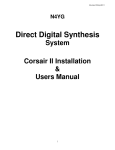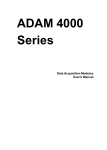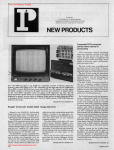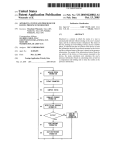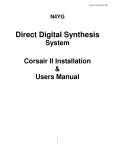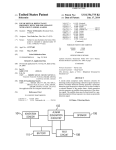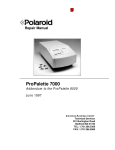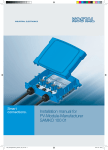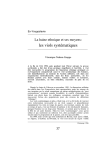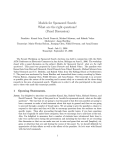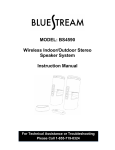Download The Microprocessor in the Biological Laboratory
Transcript
7 I 4 NW The Microprocessor in the Biological Laboratory Robert L. Schoenfeld William A. Kocsis Norman Milkman, and Gordon Silverman Rockefeller University History The use of microprocessors in the biological laboratory is a logical result of the evolution of computer use in the biomedical sciences. In 1963, H. K. Hartline and Floyd Ratliff, working at Rockefeller University in New York City, hooked up a CDC 160A computer as a generalpurpose laboratory instrument for data acquisition during their experiments on vision.' For stimulus control, they used a digital programmer constructed from commercially available discrete transistor logic circuits.2 The work in the Hartline-Ratliff laboratory was a continuation of earlier work done by Hartline on inhibitory interaction in the horseshoe crab's eye, for which Hartline shared the Nobel Prize for Physiology and Medicine in 1966, with Wald and Granit.3 Figure 1 shows the subsequent exponential growth of the use of computers in the biological laboratories at Rockefeller University. In the early years, the laboratory computer was used in studies of human learning, animal and insect behavior, and studies of various sensory systems as well as the central nervous system. The use of computer techniques in biochemistry developed more slowly, but has now become a major instrumentation technique in this and related disciplines. Although this figure illustrates the history of laboratory computers in a single institution, it may be used as an example of the use of computers and the expanding role of microprocessors in other biological research institutions and laboratories. Computers and biological disciplines To the best of our knowledge, the earliest and most widespread use of computers in biology was in the study of either the behavior of whole organisms, or in investigations of sensory or central nervous system functioning.4 We shall discuss the use of minicomputers and micro- processors in that area of work later on in this article. However, the use of computer techniques in biochemistry, which is developing very rapidly, will be taken up first. 56 35 F 30 F 25 F 201LL m 15 F 10o 5 6 63 65 67 69 71 73 75 YEAR Figure 1. Growth of laboratory computers at Rockefeller University, 1963-1976. Biochemistry. With the discovery of the double helical structure of the DNA molecule, the genetic building block of the organism, there has been rapid progress in the study of the constituent organic molecules of living tissue. The importance of these studies has been that they have given us three-dimensional models of important organic molecules; these models, together with an understanding of chemical bonds, electrical forces, and the rules of COMPUTER quantum physics, have enabled biologists to understand processes of crucial importance in the body's response to discease. The techniques involve the use of a number of instruments such as those used in gas-liquid chromatography and amino-acid analysis to separate constituents of organic molecules. Techniques such as optical spectroscopy, mass-spectrography, electron-spin resonance, and nuclear magnetic resonance are used to analyze atomic and ionic components of organic molecules, and their spatial organization can be studied directly by X-ray diffraction. The use of computers associated with these instruments developed slowly, because of the cost and complexity of both the chemical instruments and the computers available to connect with them. At that time, the computer architecture was not designed for ease in interfacing computers to laboratory equipment. The requisite skills for doing the job were also in short supply. As the manufacturers of minicomputers provided bus structures and standardized control signals to make interfacing easier, these costs decreased. Researchers developed the skills necessary to design the hardware and write the programs to provide computerized control and data acquisition facilities for chemical instrumentation. At present, the whole spectrum of computer systems is used in analytical chemistry.5'6 The use of microprocessors for instrument control is already well established. Minicomputers are used for data acquisition and the programming of serial assays or the handling of large numbers of samples. Large and powerful computers are required for sophisticated data analysis tasks that involve either large amounts of data or complex mathematical computations. Many techniques, such as nuclear magnetic and electron-spin resonance, involve extensive mathematical calculations such as the Fast Fourier Transform and curve fitting by least squares techniques.6 of light stimuli was set using manual switches and plug-boards on a digital programmer, providing three independently switched light channels.2 The equipment included lens systems, micromanipulators, and provision for light and electrical shielding. Similar experiments are now done in the same laboratory with modern minicomputers. Recently, a microprocessor-based, spatially modulated visual stimulator has been placed into service. The continuing effort in this laboratory is to study the spatial and temporal properties of the eyes of animals at various levels in the evolutionary scale.: In another laboratory, a remote Linc 8 computer monitored the responses in a cat's vestibular neurons as the cat was rocked according to a pres'cribed waveform in a hydraulically controlled platform.8 Subsequently, these and similar studies of the neural concomitants of motion have been instrumented through a DEC PDP 11/45 computer which runs experiments in two separate locations simultaneously using a real-time multiprogramming system DEC RSX-11M. This setup first required extensive interfacing of specialized laboratory peripherals -constructed from TTL logic components. Continuing studies of motion and the control of gaze have now generated the need for very sophisticated kinds of microprocessor stimulators as peripheral devices to the laboratory minicomputer. Microprocessors provide an inexpensive and convenient method to process samples sequentially or to adjust parameters of electric and magnetic fields or to displace, rotate, or collect samples or effluents mechanically. In current practice, a number of separate instruments are combined to accomplish more complex analyses. One example is the use of a gas-liquid chromatograph, followed by a mass spectrograph.7 In this method, as different fractions of a mixture are collected through the chromatograph, each component is separately analyzed by the mass spectrograph in terms of its mass components. Such a process must be monitored and controlled automatically. Currently, many of these tasks are done with minicomputers,5 but in the future, microprocessors will be more flexible and more cost-effective for this application. Physiology and psychology. Figure 2 is a rough sketch that combines the features of a number of laboratory experiments in physiology. Two microprocessor instruments are shown. One is a general-purpose stimulator that controls a paw manipulator linked to a feeding tube. Also shown, but not necessarily for the same experiment, is a control for auditory, visual, and electrical stimulation. A second microcomputer-based device is used as a data acquisition system connected to electrodes in the brain and heart muscle. The two computers are tied together to indicate that there is synchrony and control between stimulus and response. In the past, the same components were constructed using general-purpose minicomputers. In the earliest computerized experiments at Rockefeller University, a CDC 160A computer was used to acquire data from experiments on the horseshoe crab's eye.' The duration May 1977 Figure 2. Physiological experiment using microprocessor devices. In studies of learning, the experimental animal very often is human. A typical setup consists of a visual display terminal or oscilloscope with auditory output. The response is indicated by one or more pushbuttons. One may study recall of displayed words or measure reaction times to combined visual and auditory stimuli for words or textual material. Several minicomputer setups have' been used in this research over the last decade.9 57 In these and other psychological experiments the computer system and the programming become rather complex as the sophistication of stimuli, controL and data acquisition increases. An example is a visceral learning experiment. In this experiment, a rat's heartbeat is monitored while an attempt is made by a combination of auditory signals and electrical shocks to force the animal to increase or decrease its heart rate. In such experiments, while it is technically possible for a single laboratory minicomputer to control the experiment, and to acquire and process the data, the cost and inflexibility of the software and the hardware are excessive. By building a microprocessorbased electrical and auditory stimulator as a low-cost minicomputer peripheral, the system can be made much more modular. The cost of the ongoing development and changes in the experiment is thereby much reduced by distributing the computer functions. The experiment is more flexible and easier for the programmer and scientist to understand and modify. In some cases the use of a general laboratory minicomputer is unwarranted because the capacity and facilities of a typical system are excessive for the needs of the particular experiment. For example, the study of eating and drinking behavior is important because it sheds light on such pathological conditions as obesity and drug addiction. The same techniques are used also in the study of the systemic side effects of various drugs. Such studies are currently done using minicomputers hooked up to feeding and licking detectors as well as activity cages. However, the data rates for such studies are very low, so that microprocessor-based instruments either with concurrent data recording or modest mass storage capabilities could do the job as well and at a lower cost. In other cases of physiological or psychological studies, an assemblage of specialized discrete logic circuits and analog devices is put together to perform an experiment. This traditional approach is less expensive than a laboratory minicomputer but requires a great deal of design and construction effort, most of which is not transferable from one experiment to another. The components vary in quality and reliability, and the system is difficult and expensive to maintain. The cat's paw manipulator shown in Figure 2 is part of a current experiment using specialized function generators, a wired program plug board, and a special-purpose averaging computer for data acquisition.10 Hungry cats, restrained in position, are taught to manipulate the foot pedal to follow a predetermined displacement or force function, so as to maintain the position of a feeding tube to feed themselves. Concurrently, chronically implanted brain electrodes monitor electrical activity in brain cells that are involved with the learned pattern of motor activity. This experiment could be instrumented using a generalpurpose laboratory minicomputer. The required system would be expensive to purchase and would require an elaborate program. Because of the sequential nature of the conventional minicomputer architecture, this program would have tricky real-time constraints and also would not be readily transferable from this particular experiment to another. However, the use of multiple microprocessors in a distributed system as shown in Figure 2 forces both hardware and software modularity. Both the minicomputer and microcomputer solution have the advantage of hardware modularity in terms of peripherals and buses. However, the distributed microprocessor system permits simultaneous parallel processing, markedly simplifying the programming structure. The use of multiple microprocessors improves the software modularity because the different system functions are truly separate and do not require elaborate operating systems to achieve modularity. 58 A minicomputer requires a real-time multiprogramming system to have separate tasks which are controlled by a resident executive. In the simplest systems, microprocessors can exchange parameters through one-word transfers, and signal each other to start and stop their functions. Later, we shall describe more elaborate systems for distributed processing which use an executive microprocessor and peripheral microprocessor functions. The main point is that the microprocessor architecture permits a low-cost, highly parallel structure which is simpler to implement and more generally modular. Laboratory computers control peripherals - data collection and The components of a laboratory minicomputer are shown in Figure 3. The same functions are required for systems built up with microprocessor technology. The CPU for both families of devices supports a parallel bus scheme for information transfer within the system. Peripheral controllers for minicomputers were designed using small- or medium-scale integrated circuits mounted on a printed circuit board plugged into a slot on a standard backplane. The backplane slot has been standardized to contain all the bus connections and control signals needed for information transfer.11 In the past, each laboratory function required a separate controller plugged into the backplane. Microcomputers, on the other hand, can utilize single chip LSI peripheral controllers with interfaces compatible with the minimally loaded tristate bus.12,13,14 This new technology permits the construction of a microcomputer on a single board with the following LSI components: 1) microprocessor (MPU), 2) system clock, 3) read-write memory (RAM), 4) programmed read-only memory (PROM), 5) parallel input-output interfaces for laboratory control and data acquisition, and 6) asynchronous serial input- Figure 3. Minicomputer-based laboratory computer. COMPUTER output interfaces for teletype display terminals or for connection to modems for serial data communication to other computers. The specialized laboratory devices now can be constructed from medium- and large-scale integrated circuits and many functions can be packaged in one or two printed circuit boards. The microcomputer peripheral controller-interface represents several major improvements over the older technology. In general, these new devices have built in programmable flexibility and preprocessing intelligence. They are, therefore, general-purpose I/O devices rather than specialized controllers, and they may function as "smart" peripherals by providing buffer storage and a certain amount of processing capability as in the case of floppy disk controllers (discussed below). Along with these functional advantages, they require low power, have a small chip count, are small in size, and require few wired connections. Hence, the cost of constructing laboratory microcomputers is much less than was the cost for minicomputers. Digital I/O registers. In the laboratory, control signals and/or electrical measures of physiological variables are continuous (analog) or two-valued, i.e., binary (digital) informatioli. To treat continuously varying voltages, digital-to-analog conversion is required and will be discussed below. However, the computer processes binary or digital information most directly. Nevertheless, digital I/O controllers are required to serve as a buffer between the computer and the laboratory and to regulate the information transfer. Both input and output devices include a byte, word, or multiple word register. Each binary bit in the input register is set by the occurrence of a significant event in the laboratory. When the contents of the register are read into the computer and processing is started, all the bits in the input register are cleared and the device is again ready to sense the occurrence of subsequent events in the laboratory. The digital input controller may be sampled according to a programmed time schedule, or the setting of any input bit may be used to generate an interrupt to signal the CPU that one of the input sense lines is active. Binary information is made available from the computer to the laboratory via the digital output register. Each bit set by. the computer can be used to activate one or more solenoids, relays, electrical, sound, or light stimuli in the laboratory. Measured amounts of gas or liquid can be released in this way. Stimuli can be applied for precise periods of time of the order of tens of microseconds to seconds or hours. By manipulating the individual bits of the output register to drive suitable buffer drivers, a great variety of control functions can be executed. Digital I/O registers can also be used in a parallel mode to read or preset counters and timers external to the computer, or to transfer parallel information to another computer. There are significant differences between mini-based and micro-based digital I/O controllers. The minicomputer peripherals are implemented with discrete logic or smallscale integrated circuits, so they usually have more limited functional capacity. The control signals used to request, acknowledge, or gate a binary word transfer on the microcomputer-based systems are program modifiable. For example, the Motorola peripheral interface adapter (MC6820) has four control signals which can be used, in connection with an internal data direction register, as input or output control signals in edge-, pulse-, or level-sensitive modes.'5 The dual 8-bit registers of this device can be programmed as inputs or outputs, or they can function as bidirectional data pathways. Intel's programmable peripheral interface (8255A) contains three I/O ports, one of which can be used May 1977 for handshaking signals.16 The price of this flexibility is increased programming complexity. However, the versatility of these control modes increases the number of devices that can be connected to the digital I/O port without requiring additional circuitry to achieve compatibility. Analog-to-digital and digital-to-analog converters. A/D converters'7 are used in physiological experiments when the precise waveform details are under study. In cases where multiple nerve signals are monitored with a single recording electrode, the waveshape of the electrical nerve impulse must be sampled to distinguish the signals.'8 In cardiology research and clinical medicine the form of the heart muscle potential is of key interest. In analytical chemistry the waveform or time-varying spectrum of a chemical must be measured and stored. A/D converters are used whenever the amplitude vs. time course of a physiological or physical variable needs to be stored in computer-compatible form. D/A converters produce analog output voltages from computer stored lists of numbers. Two digital-to-analog converters can be used to control oscilloscope displays of alphanumerical information, data plots of visual stimulation patterns. Alternatively, the analog voltage can modulate the output of a physiological stimulator or other continuous control device. Monolithic and hybrid, dual-in-line packaged A/D and D/A converters are becoming available as microcomputer bus components. Since the data is held on the bus for only one cycle, the D/A converter must have data latch registers to retain their binary input data from the computer to hold the proportional voltage or current at the output. This capability is found, for example, in the Analog Devices AD7522.19 If the required precision is greater than 8 bits, then the latch register and the control signals must accommodate double inputs from the computer in the case when the latter has a byte-oriented data bus. The A/D converters usually require tristate drivers for low leakage. Programmable clocks. This device has several functions which are usually not available simultaneously. It includes a word-sized counting register plus a buffer which holds a presettable count. Several internal clocking rates or external ones are selectable by program. Counter overflow and external event interrupt are available. In one application, a timing source decrements a preset value to signal a predetermined time interval. For example, a set of timed electrical stimuli could be generated in this way by setting successive values in the programmable clock register. The same technique could be used to time the mixing of reagents in a chemical experiment or to control the sampling time of an A/D converter or of a digital input line. The programmed timer may also be used to measure the time interval between significant events in an experiment. In electrophysiology the significant data may be nerve firing rates. These are obtained by processing data acquired as a list of time intervals between nerve impulses. The computer calculates the reciprocal of the time increments acquired during the experiment.'8 In analytical chemistry the time required for a reaction to reach a measurable state may be required. The programmed timer performs all of these functions. A third usage is to count the number of events in a clocked time interval. This application, called "binning," has many applications in research and measurement. The computer itself could perform these timing functions by using external timing sources and by, programming 59 waiting loops between clock ticks. However, this would tie up the computer during the passage of the real time elapsed. The use of one or more programmed timers and external clocks enhances the parallelism of functions in laboratory computer applications. This peripheral is so widely used in control applications that is has been included in Intel's MCS-48 single chip microcomputer system.20 As a separate peripheral the Intel 8253 programmable internal timer contains three independent 16-bit counters.21 Each counter can be set to reach a preset count, either in a binary or binary coded decimal mode. A feature such as the BCD counting mode distributes the processing more evenly between the MPU and the LSI timer peripheral. LSI controllers for mass storage devices. Mass storage devices, especially magnetic tapes and disks, are used as intermediate storage media with slower access than primary core or semiconductor memory, but at a lower cost per bit. These devices are found in practically every laboratory computer system, with the floppy disk becoming most popular. Western Digital's Floppy Disk Formatter/ Controller FD1771' is an LSI controller which handles read/write head positioning and loading as well as parallelserial conversion for reading and writing binary data onto the flexible diskette." Several registers within the chip hold track and sector addresses, binary data to be read or written, cyclic redundancy check values (a technique for validating the accuracy of data transferred- to and from the diskette),23 the current command being executed (READ SECTOR, WRITE SECTOR, SEEK TRACK N, etc.) and error and status information. This chip, together with LSI digital I/O chips, line-drivers, and several monostable multivibrator timers can be used as a very low chip-count controller. This is another example of distributed processing and system intelligence. The many varieties of microprocessor instruments In our discussion of biological applications, an indication was given of the variety and sophistication of laboratory computer interfaces and the complexity and diversity of the programs required. Several standard' hardware packages are marketed as laboratory computers.'4 More recently, microprocessor systems that emulate minicomputers have appeared. Intersil markets a CMOS emulation of the DEC PDP-8 computer, complete with floppy disk, controller, teleprinter, and 4K of memory." Digital Equipment Corporation sells packaged versions of its LSI-11 computer that emulates all of the functions of the traditional PDP-11 series.'6 MITS sells packaged versions of the Intel 8080 and Motorola 6800 microprocessor, complete with memory of various kinds, disks, line printers, teleprinters, cassettes, and CRT terminals.'7 The traditional minicomputers and the newer microprocessor-based emulations of them offer the advantage of mature program development software and operating systems. 'In the computer's role as a scientific instrument, it is important to separate the functions of source program development, object program loading, and program execution. It is both inexpedient and unnecessarily expensive to combine all of these functions in every single microprocessor-based laboratory instrument. As a matter of fact, one of the difficulties in the use of traditional laboratory minis is that one had to spend $25,000 for a system with a self-sufficient program development capability to perform what is 'now a $2000 to $5000 scientific laboratory function. In many ways a general-purpose microcomputer is not well matched, with the requirements of a laboratory experi60 ment in physiology. The general-purpose computer system with a single sequential processor does not meet the varied requirements of any single series of experiments or those of a number of slightly different experiments without extensive and expensive applications programming. Usually, the manufacturers' or users' society applications programs don't quite fit the needs of the particular application. A professional programmer or technically skilled amateur such as a graduate student is usually required to do the job. With the use of a centralized programming facility for many applications, and the construction of specialized turnkey microcomputers, each programmed to perform either a single laboratory function or a modular portion of a more general application, the repetitive software engineering demands of the biological laboratory application can be minimized. One obtains the hardware standardization lacking in systems constructed from discrete logic without requiring as much programming effort as needed with general purpose minicomputers. One also reduces the expense of the computer installation for tasks requiring only simple instrumental functions. Stand alone instruments. A microprocessor-based instrument performs its function or one of its functions by executing a program. Its read-only memory is loaded permanently with a single program. Such an instrument may have varying amounts of read-write memory for storage of parameters and data. The program being executed can be as flexible as the memory size will allow. Typically, it includes subroutines, I/O controlled branching sub-programs, interrupts, halts, and restart options. This infrastructure is transparent to the user, for whom the computer part of the instrument is not even present. The instrument/human interaction occurs by means of pushbuttons,' panel switches, jacks, and cables to other instruments and transducers. In our laboratory, we have built instruments with as few as two switches or as many as two dozen. One can use outputs such as pen recorders, CRT or LED displays, or digital printers. In instruments with more flexible functions, a hexadecimal keypad has proven to be an extremely flexible, easy-to-learn and-use, fast-acting control device. This experience is in accord with the human engineering embodied in office business machine practice. Activity detection system. Figure 4 shows a simple microprocessor-based system for simultaneously detecting movement or licking in 12 animal cages. In the current version of this instrument, the output is produced by a small digital printer. A sample hard-copy output is shown in Figure 5. As can be' seen from the figure, the data output from this device is hardly in the most convenient form for analysis. Under development is the obvious second step, a floppy disk storage device to provide a computercompatible mass storage medium, so that the data may be processed off-line and meaningful summary results presented to the experimenter. However, the availability of immediate hard copy is important in monitoring the ongoing progress of the experiment and to make sure that the whole system is working properly. The lick and activity detectors are crucial to the operation of this instrument. The lick detector transducer utilizes the change in resistance presented by the animal (a mouse or a rat) between the floor of the cage and the mouth contact with the metal tube containing the liquid food or water. The activity detector is a light-photodiode circuit which is interrupted by the motion of the cage rotating. The signal triggers a bistable circuit which is reset when the cage returns to its initial position. The set and reset angles can COMPUTER wDATA _ -**- CONTROL AND ADDRESS HRS. 0.1 HRS. INTERVAL ~~~~~~~~~~~CEl Ef'T CI\AITPU]EC 6ELtt I 6VY I Ut.L Time Figure 4. 24-channel activity data recorder. be adjusted so that the definition of "activity" can be determined experimentally. The lick detector activates a monostable multivibrator with a delay time of 100 milliseconds. Thus, the behavioral rates are limited to approximately 10 per second to define a maximum level of licking and movement and to distinguish quantum units of behavior from variability within it. There is need for other more sophisticated measures of animal behavior, such as the ability to time inactivity or time. spent in restricted areas of the cage. We hope to expand the repertoire, number, and types of measurements that can be made. The digitized signals are connected through amplifiers which drive long cables which in turn are buffered into the microprocessor I/O circuits. A master clock sends a signal to the microprocessor every 90 milliseconds. When this clock signal is detected, the digital data at the terminals is sampled in 8-bit bytes. The data is subsequently unpacked into 24 separate channels of information, and a count is added to a number being stored in each channel in RAM. When a time period has elapsed corresponding to that manually selected on a set of thumbwheel switches, a signal is sent to the microprocessor to initiate the readout of the data stored in RAM. The time interval between data retrieval is selectable from 0.1 to 9.9 hours. The printout format is shown in Figure 5. No loss of data can occur during the printing, since the sampling of input data goes on concurrently with the action of the printer. Histogram-integrator-averager. This device has capabilities similar to those of several well-known commercial special-purpose computers.10 Known as "average response computers" or "histogram generators" and often including options for spectrum analysis, these computers have found application in radiation monitoring and analytical chemistry, as well as in neurophysiology. As a matter of fact, May 1977 Time format wwxxyyzz ww = day xx = hours yy = mins. zz = secs. 20144747 20144747 20144747 20144746 20144746 20144746 20144745 20144745 20144745 20144744 20144744 20144744 20144743 20144743 20144743 20144742 20144742 20144742 20144741 20144741 20144147 20144147 20144147 20144146 20144146 20144146 20144145 20144145 20144145 20144144 20144144 20144144 20144143 20144143 20144143 20144142 20144142 20144142 20144141 20144141 Trial No. of licks no. or wheel turns 02 02 02 02 02 02 02 02 02 02 02 02 02 02 02 02 02 02 02 02 01 01 01 01 01 01 01 01 01 01 01 01 01 01 01 01 01 01 01 01 0114 0128 0000 0004 0000 0140 0131 0000 0000 0000 0000 0000 0000 0000 0000 0000 0000 0000 0000 0000 0113 .0142 0000 0002 0000 0065 0089 0000 0000 0000 0000 0000 0000 0001 0000 0000 0000 0000 0000 0000 Channel20 - Channel 1 Figure 5. Paper tape printout of rat activity and licks; 6 minute records. 61 several general-purpose computers manufactured about 10 years ago, notably the DEC PDP-15, had a special CPU instruction to permit the averaging function. In the earlier devices, the basic idea was to access a random access core memory sequentially, while simultaneously obtaining a digital representation of a physical variable being sampled. The input variable might be a voltage amplitude, a pulse height, or the number of pulses counted during a sampling interval. The logic of the device consists of adding the sampled value to the value in the memory location currently accessed and storing the result back in that same memory location. At the end of the run or sweep through all of the memory locations, a second sweep is undertaken in which the summed values are averaged and displayed on an oscilloscope or pen recorder.'7 A decade ago, this device cost about $10,000. It required a minimum amount of core memory and a very limited kind of central processor. These instruments are still widely marketed. Their price has not changed very much in 10 years, but some of the features have been expanded. The cost of this instrument can be reduced markedly using microprocessor technology. A block diagram of the instrument built in our laboratory is shown in Figure 6. In the integration mode, an analog voltage input in the range of ± 1 volt is rectified and applied to a voltage-to-frequency converter. Using a relatively high bandwidth operational amplifier to ensure a highspeed flyback circuit, and switching time capacitors, it is possible to achieve 0.2% linearity over the voltage range and to control the maximum frequency output over a 6decade range. In the intended application, the instrument is used to monitor the "activity" of multi-fibered muscles or nerves where a number of units are firing simultaneously. The digitized values of the integrated activity over 341 time bins are stored in the main memory of the microcomputer. The instrument is used in an "average response mode" Notes: 1. Data lines tor microprocessor so that each trial is linked to a stimulus or other timed determinant of activity. Successive trials are summed in 341 double-precision memory locations. At the conclusion of each trial an oscilloscope display or hard copy of the integrated activity is obtained, and at the end of the set of runs, the sum of all trials is divided by the number of trials and the computed average is stored in the memory for scope display or plotting. This technique has been widely used in neurophysiology to study activity in which time-determined responses are mixed with a random component. As the number of trials is increased, the amplitude of deterministic components increases linearly with the number, while the random components increase as the square root of the number of trials. Theoretically, then, if the system behaves according to this model, the signal-to-noise ratio of the averaged response increases as the square root of the iumber of trials.17 As shown in Figure 7, which indicates responses in a taste nerve to dilute potassium chloride, the histogram mode performs a similar process in the domain of single unit responses following a stimulus. The instrument memory is accessed in such a way that a 32-unit area is cyclically addressed during the pre-trial interval. Consequently, in the display, the region between the two dots represents a random arrangement of the pre-trial counts. At the second dot, a post stimulus plot of counts per 10millisecond time interval is obtained. The figure illustrates the output of the instrument on a pen recorder to three separate trials and to the average of all trials. The instrument includes a Schmitt trigger or comparator circuit so that the occurrence of a neural event may be differentiated from the background activity. The multiplexer output is a composite signal which includes the triggering level of the Schmitt trigger, its pulse output, and the input analog signal. The experimenter thus can adjust the triggering level by studying this display on an oscilloscope. w 2. When mode switch set to integrate, PIA receives full scale counts of 512. When mode switch set to histogram, PIA receives selected count. Figure 6. Histogram-integrator-averager. 62 COMPUTER FIRST TRIAL BIN NUMBER- FIRST__ BIN 341 .1 " ... . 256 COUNTS THIRD TRIAL AVERAGE OF ALL TRIALS Figure 7. Post -stimulus histogram. 0.1N KCL. Rat chorda tympani. The current version of the histogram-integrator-averager is a limited instrument. It is planned to expand it in several ways. The most immediate expansion is the provision of a floppy disk storage medium to save the numerical trial values and the sums for later, more extensive data analysis. Using larger memories and/or a microprocessor with a 16bit word size, it would be possible, as in the commerical counterparts of this instrument, to store and average several data channels at once. With this facility, it would be expedient to build a separate microprocessor-based unit to compute auto- and cross-correlograms and power density frequency spectra for the data obtained. Such analyses are frequently employed in processing neuroelectric data. Visual stimulator. The basic idea is to generate contrast displays on a standard CRT to be imaged through a lens system on an animal or human eye to test responses of the visual system (see Figure 8). The repertoire of the instrument includes a combination of temporal and spatial rectangular fields of illumination. The patterns include a contrast reversal (flashing) bar, a drifting bar grating, a contrast reversal sinusoidal grating, and a drifting sinusoidal grating. The contrast reversals can be sinusoidal or square wave functions. The degree of contrast, velocity of movement, the spatial and temporal frequencies, and the width, position, and orientation of the display to the vertical are parameters of the instrument. They are controlled through a manual key pad. The instrument includes two facilities for data acquisition. The data are nerve impulses or slow potentials obtained in response to the visual stimulus presented. Post-stimulus histograms for either type of data are formed in RAM memory. Additionally, four double-precision locations are used to store the sine and cosine Fourier coefficients of the fundamental and second harmonic of the temporal frequency response of the spike data. The histogram data may be displayed on an oscilloscope or plotted on a pen recorder. The Fourier coefficients are available on a front panel numerical LED display. The visual stimulator is controlled by a hexadecimal key pad which loads parameters into a 128-location RAM memory. The entry format is nX, where n is a decimal number and may consist of from zero to six digits to define a magnitude, select a value for a parameter or subfunction, and X is one of the first six alphabetical characters, A to Figure 8. Visual stimulator displays. May 1977 63 F, defining a function. The key pad operation is easy to learn and with use can be operated so that the entire repertoire of the instruments can be executed in a few minutes. This instrument, in the two versions that have been built, has proven to be a very important tool for visual research. A third model is in the design stage. It also has obvious possibilities for use in clinical studies of human vision, which remain to be explored. A computer peripheral: stimulators for electrophysiological experiments. Figure 9 shows a block diagram of a microprocessor-controlled constant current stimulator which was built as a peripheral device to a DEC PDP-8E laboratory computer. Most of the components of this device were built on a single standard mother board supplied with the components for a programmed data interface with the PDP-8E computer."' As shown in the figure, this device plugs into the omnibus of the PDP-8E. Cables are run to three remote stimulus isolation units. These are small units in miniboxes brought inside a shielded enclosure where the experimental work is done. Optical couplers pairing light emitting diodes and photodetectors are used to isolate the computer system ground reference from that of the biological preparation. This is necessary to prevent the electrical stimulus from coupling electrostatically to the data recording electrodes and swamping the nerve response, which is many orders of magnitude smaller in amplitude than the stimulus. This device is capable of controlling three separate stimulators. The PDP-8E host computer is used to transfer parameters to the microprocessor control unit and to gate the start of the programmed stimuli. The microprocessor then executes a general-purpose stimulation program stored in its PROM, using the parameters from its RAM to control the particular stimulus pattern required for the experimental run. At the conclusion of the called-for stimuli, the microprocessor sends an interrupt request to the host computer indicating that it is ready to repeat the stimulus or receive new parameters from the host. The repertoire of commands includes the ability to set the current amplitude for each of the three stimulus isolation units. All time intervals for stimulation must be sequential, since these are executed one after the other under control of the microprocessor clock. The minimum time interval permitted by the hardware is 30 microseconds - this time being determined by the instruction execution time and the number of instructions needed to set up the requisite programming delay loop. Six time intervals may be set. The first of these is the time between the start pulse and the first stimulating pulse. Provision is made for a dynamic range of 224 in this delay time i.e., up to 160 seconds with a resolution of 10 microseconds. Three sequential triple-precision pulse widths may be set followed by an inter-pulse interval. Another parameter permits setting the number of times the pulse pattern may be repeated. The final timing parameter defines an interval between successive trains of pulses when the instrument is set in the continuous train mode. Another parameter defines the mode as a single or continuous train. The instrumeht is reset and started by the host computer. A separate parameter permits assignment of any one or all of the three stimulators to any combination of pulse widths. These constraints permit the providing of an output to one or more of the stimulators in which two pulses can be moved arbitrarily in time with respect to one another. The flexibility of this instrument could be enhanced by using separate programmed timers in parallel to determine pulse widths and by using the processor to determine a set of sequential time durations. A typical use of this stimulator is shown in Figure 10. In one such application, a rat is trained to raise or lower its heart rate. A train of electrical stimuli is applied and the heart rate measured. If the rat's heart rate doesn't respond in the right direction, the amplitude and/or the number of pulses in the stimuli are changed. As the animal responds correctly to the stimuli, the number and amplitude of the pulses are reduced. In such an experiment, the system follows the threshold for the desired response.'8 Prospect for future biological microcomputers The electrophysiological stimulator discussed is an example of a microprocessor-based peripheral controller used as a one-word transfer peripheral to a standard minicomputer. One could, of course, construct a similar system using a microprocessor emulator for the central computer. However, for best results in the biological application as well as in many others, a different level of device is needed. The small size and low cost of the microcomputer architecture make it possible to provide a separate' microprocessor for each separate function. Figure 11 shows a conceptual model of a microprocessor-based laboratory microcomputer made up of a number of separate units, each with its own MPU, ROM, and RAM, but with an executive unit having shared direct memory access to the individual read/write memories. The executive would synchronize and control the sequence of the various processes. CONTROL Figure 9. Microprocessor controlled current stimulator. 64 Figure 10. Reinforcement or datadependent stimulation. COMPUTER This design would provide high-speed parallel functions and would lend itself to modularity in construction and in software. Only the portion of the system software and hardware which interfaces with a particular laboratory experiment need be custom tailored for that application. The main part of both the construction and the software "handlers" for components such as the digital input module or the floppy disk module could be general-purpose. In certain applications, it might be possible to design the software and the hardware so that only certain key parameters of the system need be changed. With this approach, it is possible to construct components for a general laboratory microcomputer, which may be particularized for a given experiment by changing the firmware and parameters of the executive and only one or two peripheral devices. A neurophysiology microcomputer. As a result of the experience gained from the several devices discussed, one can envision a general-purpose microcomputer oriented toward experiments in neurophysiology and animal behavior. As indicated in Figure 11, it would include mass storage devices and possibly an asynchronous interface to larger computers. These components and the firmware to execute their function could be general or, at most, several different "handlers" could be written to encompass different data formats or data rates. - FD DISKETTE MPU .- - - - - - -v _ _ IBM RAM. BUFF ER On the other hand, the data acquisition portions of the system and the stimulators and experimental control functions should be specialized to the application. We have three projects on the drawing boards, with very sophisticated stimulator requirements. For example, in the system illustrated in Figure 2, it would be desirable to provide a forcing function illustrated in Figure 12 applied to the cat's paw manipulator. The task of the animal 'Would be to maintain the position of the manipulator -constant when it was subjected to the function shown. The combination of sinusoidal and piece-wise linear comp9nents is thought to be most useful in defining the neuroXnuscular system active in such complex learned behavior. Such a time-dependent stimulus can be generated by combining two algorithms. Sinusoidal components of the desired resolution can best be generated in a microprocessor, as indicated by our experience with the visual stimulator by storing a list of pre-calculated sine values6. Linear segments can be computed dynamically. Thus,"by combining pre-calculated trigonometric functions and dynamically calculated linear values, one can produce -arbitrary waveforms in the bandwidth region of D-C to 100 Hertz, which is the region of physiological interest. In studies of the visual system it is desirable to. produce a forcing function which is the sum of six to eight sinusoidal frequencies which have the property that the low order intermodulation frequencies are not members of the fundamental set of frequencies. This could be done by choosing frequencies among the prime numbers, or approximately by choosing them to be related such that ni = M 2i-1 -1 where M is an integer greater than or equal to 4. The second method is easier to implement with a computer. For a system with small non-linearities the Fourier components of the fundamental and first sum and difference frequencies give an effective characterization of the visual system. Moreover, if the response to the stimuli are nerve spike trains (basically trains of impulse or delta functions), then one can calculate Fourier coefficients dynamically using single- or double-precision registers. For six to eight components, one generates 36 to 64 response frequencies.29 AMPLITUDE II - i\ -I Tl-ME Figure 12. Force function for cat's paw manipulator. EXECUTIVE BUS _ - - - - - - - INTRAMODULE BUS Figure 11. Distributed microprocessor-based laboratory computer. May 1977 The important advantage of this method of testing a biological system is that one can characterize it by the response to two or three cycles of the lowest fundamental frequency of the stimulating waveform. One thus avoids the problem of adaptation or deterioration in the biological preparation. More conventional methods such as a Bode plot would require a long stimulating period during which the biological system might change. Alternatively, impulse or step stimulation might carry the system over into the range of strongly non-linear behavior which is disruptive of the information of interest. 65 In studies of the neural mechanisms of directing the gaze in cats, there is need for stimuli including amplitude and frequency modulation and the simultaneous presentation of both amplitude and frequency modulated stimuli. In addition, one wishes to be able to switch stimuli rapidly from one to another among an array of possibly 20 electrodes. There is need for bipolar stimulus amplitudes with each polarity independently controllable.30 Some of these projected instruments will be standalone devices. Others will interface with standard laboratory computers. Still others will connect to the type of distributed microcomputer network discussed above. The versatility and expansion capabilities of microprocessor instruments are virtually unlimited. Microprocessor development facilities We have found that the most effective system for developing microprocessor firmware is the use of a dedicated minicomputer system with disk storage and line printer facilities. Currently, we are using a DEC PDP8-L as the host computer for this facility. As illustrated in Figure 13a, we have built an EPROM programming interface, which permits entering a program into an ultra-violet light erasable programmed read-only memory. An appropriate PDP-8 based program allows an object program to be transferred from the host computer's file storage byte by byte to the EPROM. PDP-8 resident cross-assemblers for the Intel 8008 and 8080 as well as the Motorola M6800 microprocessor systems are available from commercial sources. We had modified an earlier version of an Intel 8008 cross-assembler available from DEC. Fig. 13b illustrates a prototype Motorola M6800 microprocessor system which is used for testing microprocessor software and hardware. The device may be tested by loading the object program in RAM memory and allowing it to execute with the ultimate peripheral devices in place. With an appropriate PDP-8 program, it is possible to use the teletype to load s-ubroutines and program segments into the microprocessor RAM to test these routines in real time. Thus, it is possible to expedite the writing and testing of program segments with the convenience of a larger system with more complete facilities, but in the actual microcomputer environment for which it is intended. For on-site testing, we have also used the Pro Log tester which allows one to step through the program with address and data availability.31 A planned expansion of these facilities would include a host computer for 16-bit microprocessor program development, loading, and testing. Applications which require a greater amount of numerical calculation and data storage, such as the sophisticated neurophysiological stimulators discussed, might be implemented more effectively using larger word size microcomputers. On the other hand, simpler devices for process control might be implemented using 4-bit architectures. In any case, it seems clear that a wide horizon exists for biological micropro- cessors. Conclusion The particular advantage of microprocessor systems, in addition to their low cost, is that they lend themselves to modular distributed parallel processing. This feature opens up the possibility of constructing sub-units such as a diskette controller and driver with standardized firmware. The applications program required for a particular experiment might be reduced to a list of parameters or, at most, one or two program segments plus an executive sequencer or task priority assignment schedule. These new features open up the possibility of reducing the cost of both the hardware and programming of a particular laboratory computer, and allowing a set of modular software and hardware components in an institution to support a multiplicity of scientific tasks in different laboratories. U PDP8/L PROM BLASTER INTERFACE References 1. R.L. Schoenfeld, "The Role of a Digital Computer as a Biological Instrument," Annals of the New York Academy of Science, Vol. 115, No. 2, 1964, pp. 915-942. 2. N. Milkman and R.L. Schoenfeld, "A Digital Programmer for Stimuli and Computer Control in Neurophysiological Experiments," Annals of the New York Academy of Science, Vol. 128, No. 3, 1966, pp. 861-875. PDP8/LM6800 INTERFACE PROTOTYPE 6800 Figure 13. Microprocessor test and fabrication facility. 66 3. H.K. Hartline and F. Ratliff, "Spatial Summation of Inhibitory Influences in the Eye of Limulus and the Mutual Interaction of Receptor Units," J. Gen Physiol., Vol. 41, 1958, pp. 1049-1066. 4. W.A. Rosenblith, "Processing Neuroelectric Data," M.I.T. Res. Lab. of Electronics, Tech. Rep. 351, 1959. 5. B.E. Bowen, S.P. Cram, J.E. Leitner, and R.L. Wade, "High Precision Sampling for Chromatographic Separations," Anal. Chem., Vol. 45, No. 13, Nov. 1973, pp. 2185-2191. COMPUTER 6. G. Brouer and J.A.J. Jansen, "Deconvolution Method for Identification of Peaks in Digitized Spectra," Anal Chem., Vol. 45, No. 13, Nov. 1973, pp. 2239-2247. 7. H.R. Schulten and H.D. Beckey, in Advances in Mass Spectrometry, A.R. West, ed., Vol. 6, Applied Science Publishers, Barking, Essex, 1974, pp. 499-507. 8. R.H. Schor, "Responses of Cat Vestibular Neurons in Sinusoidal Roll Tilt," Exp. Brain Res., Vol. 20, 1974, pp. 347-362. 9. G.A. Miller, A.S. Bregman, and D.A. Norman, in Computers in Biomedical Research, R.W. Stacey and B. Waxman, eds., Vol. 1, Academnic Press, New York, 1965, pp. 467-491. 10. Nicolet 1070 Series Signal Averager, available from Nicolet Instrument Corporation, 5225 Verona Road, Madison, Wisconsin. 11. "PDP-8 Small Computer Handbook," Digital Equipment Corporation, 1973, Maynard, Mass. 12. J.E. Bass, "A Peripheral-Oriented Microcomputer System," Proc. of the IEEE, Vol. 64, No. 6, June 1976, pp. 860-873. 13. "M6800 Microprocessor Application Manual," Motorola Semiconductor Products, Inc., Box 20912, Phoenix, Arizona, 85036, 1975, pp. 4-1 to 4-88. 14. D.G. Larsen, P.R. Rony, and R.A. Braden, The Bugbook II - Logic and Memory Experiments Using TTL Integrated Circuits, EEL Instruments Co., Derby, Conn., 1974, pp. 7-1 to 7-26. 15. A. Osborne, An Introduction to Microcomputers, Vol. II, Adam Osborne and Associates, Inc., Berkeley, California, 1976, pp. 6-40 to 6-50. 16. A. Osborne, ibid., pp. 4-74 to 4-84. 17. R.L. Schoenfeld and N. Milkman, "Digital Computers in the Biological Laboratory," Science, Vol. 146, No. 3641, Oct. 9, 1964, pp. 190-198. 18. R.J. O'Connell, W.A. Kocsis, and R.L. Schoenfeld, "Minicomputer Identification and Timing of Nerve Impulses Mixed in a Single Recording Channel," Proc. of the IEEE, Vol. 61, No. 11, Nov. 1973, pp. 1615-1621. 19. "CMOS 10-Bit Buffered Multiplying D/A Converter," Specification Sheets and Applications Notes, Analog Devices, Route 1, Industrial Park, P.O. Box 280, Norwood, Mass. 92062. 20. "MSC-48 Microcomputer User's Manual," Intel Corporation, Santa Clara, California, 1976. page 2-8. 21. Ibid, page 7-89. 22. "Floppy Disk Formatter/Controller Specification FD1771," Western Digital Corporation, Newport Beach, Ca., 1975. 23. "M6800 Microprocessor Application Manual," op. cit., p. 5-245. 24. "Digital Equipment Corporation DECLAB Family," Sales Brochure, Digital Equipment Corporation, Maynard, Mass. 1976. 25. A.T. Thomas, "Architecture and Applications of a 12-Bit CMOS Microprocessor," Proc. of the IEEE, Vol. 64, No. 6, June 1976, pp. 873-881. 26. M.J. Sebern, "A Minicomputer-Compatible Microcomputer System: The DEC LSI-11," Proc. of the IEEE, Vol. 64, No. 6, June 1976, pp. 881-889. 27. "Altair 8800," advertisement in Mini-Micro Systems, December 1976, pp. 12-13, MITS, 2450 Alamo SE, Albuquerque, N.M. 87106. 28. G. Silverman, G.G. Ball, and C.K. Cohn, "A New Automatic Constant Current Stimulator," IEEE Trans. on Biomedical Eng., Vol. BME-22, No. 3, May 1975, pp. 207-212. 29. J. Victor, Private Communication, Feb. 1977. 30. B. Peterson, Private Communication, Feb. 1977. 31. M823 6800 System Analyzer Specification, Pro-Log Corp., 1975, 2411 Garden Road, Monterey, California 93940. May 1977 Robert L. Schoenfeld is an associate professor and co-director of the Laboratory of Electronics and Computers at Rockefeller University. He has been with the university since 1957, working primarily with the planning and managemehit of design and development efforts in the application of electronic and computer techniques to biological laboratory experiments. From 1947 to 1966 Schoenfeld taught electrical engineering at Polytechnic Institute of Brooklyn. He was a research associate in neurology at Columbia Medical School from 1947 to 1951. He worked in nuclear radiation instrumentation for the N. Y. C. Department of Hospitals and Sloan-Kettering 'Cancer Research Institute where he did his doctoral research'and later was a post-doctoral fellow. Schoenfeld received the BA from NYU in 1942, the BEE from Columbia University in 1944, and the MEE and DEE from Polytechnic Institute of Brooklyn in 1949 and 1956, respectively. Schoenfeld has been active in the PGEMB; was on the organizing committee for the 1966 and 1969 International Biophysics Conferences; is on the editorial board of the IEEE Spectrum; and is a member of Sigma Xi and an IEEE Fellow. William Kocsis is a project engineer in the Electronics and Computer Laboratory at Rockefeller University. His responsibilities have included minicomputer-based data collection and control systems and computer interfaces for biological laboratory experiments. He has been responsible for developing the g _p, microprocessor fabrication facilities described in this paper as well as for the design of microprocessor stimulators. Kocsis has been employed at Rockefeller University since 1972 when he completed his BE at New York University. He is completing supplementary course work in biology and chemistry at Columbia University. He is a member of Sigma Xi and the IEEE. Norman Milkman has been a member of the Electronics and Computer Laboratory at Rockefeller University since 1962. He presently holds joint appointments as an affiliate in that laboratory and in the Biophysics Laboratory. Milkman is equally at home doing electronic design, computer interface development, and software engineering. He is currently designing microcomputers for vision research. From 1949 to 1961 he was a senior project manager at Budd Electronics Company, responsible for the design and development of digital data processing equipment used in the "Sage" early warning system. Milkman received the BSEE from Pratt Institute in 1949 and the MSEE from Brooklyn Polytechnic Institute in 1963. He is a member of Sigma Xi and IEEE. 'Gordon Silverman is an affiliate in the Electronics and Computer Laboratory of Rockefeller University. He also serves on the adjunct faculty of Fairleigh Dickinson University where, among other courses, he teaches a graduate course in microcomputers. Before joining the university in 1964, he was associated with the research activities of ITT Labs and Loral Electronics Corporation, where he was involved in employing digital techniques in reconnaissance, navigation, and anti-submarine warfare. He received the AB, BS, and MSEE degrees from Columbia University in 1955, 1956, and 1957, respectively. He received the PhD degree in system science (EE) from the Polytechnic Institute of New York in 1972. Silverman is a member of Sigma Xi and the IEEE. He has served on the editorial boards of the Review of Scientific Instruments and IEEE Transactions on Biomedical Engineering. 67












